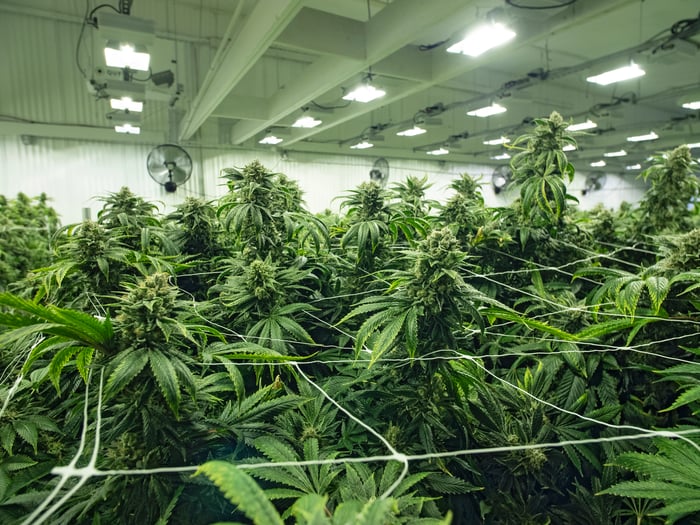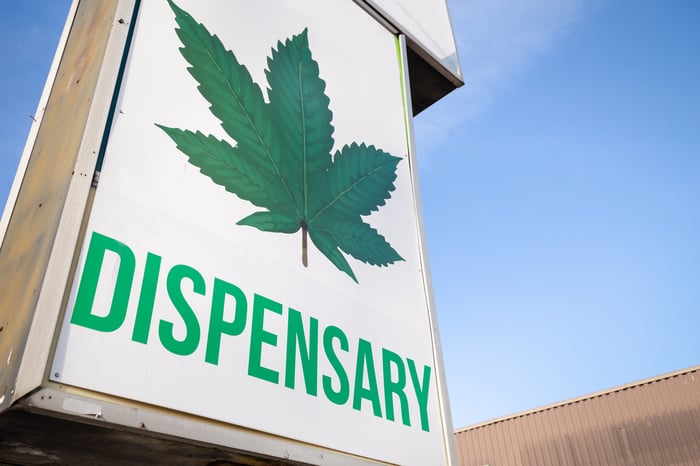It's truly incredible what a difference a year can make. Although the launch of dried flower in Canada didn't go as smoothly as expected, the widely held belief, as of Jan. 2019, was that cannabis stocks would be pushing into the profit column by the end of the year, if not early 2020.
However, the reality is that marijuana stocks are, for the most part, nowhere near profitability. In fact, some of the most popular pot stocks have reversed course and are even worse off than they were at this time last year, in terms of their bottom lines. According to Wall Street's consensus, the following five pot stocks have no chance of generating a recurring profit until 2022, at the earliest.

Image source: Getty Images.
Aurora Cannabis
Being the most popular marijuana stock in the world can only take a company so far. Despite Aurora Cannabis (NYSE:ACB) being the most-held stock on online investing app Robinhood, the tide has most definitely turned on Wall Street, with a handful of analysts anointing the company with a sell rating.
Pretty much all of Canada has been adversely impacted by supply issues in a number of key provinces. For example, Ontario had only approved 24 dispensaries at the one-year anniversary of the adult-use sales commencing (Oct. 17, 2019). This works out to one open retail location for every 604,000 people in the province. It's led to a significant supply backlog in Canada's most-populous province, and it's caused a number of producers, including Aurora Cannabis, to significantly cut back on production in the interim.
Perhaps the bigger concern for Aurora is that Wall Street doesn't believe the company has enough cash on hand to meet its debt obligations and ongoing expenses. Aurora has made a habit of issuing its stock like Monopoly money to fund acquisitions and ongoing expansion activity, but this doesn't look too feasible any longer with its share price sinking well over 80% in 10 months.
Long story short, Aurora Cannabis is a long shot to push into profitability before 2022.

Image source: Getty Images.
Canopy Growth
Canopy Growth (NYSE:CGC), the largest pot stock in the world by market cap, is another cannabis stock that looks to have virtually no shot at recurring profitability prior to 2022. In fact, Wall Street's consensus per-share loss estimates have continued to worsen over the past three months.
In terms of operating losses, Canopy Growth has led the pack -- and this isn't a category a company wants to lead the field in. Canopy's expansion has led to a number of new hires, which, along with marketing expenses, have shot the company's expenditures through the roof.
Of course, the biggest culprit just might be share-based compensation. Prior to being fired in early July, former co-CEO Bruce Linton believed that giving employees long-term-vesting stock was the best way to keep them motivated and loyal to the company. Unfortunately, this stock is expressed as an expense on the company's income statement, and it alone totaled more than net sales did during the fiscal second quarter.
Canopy Growth does have a new CEO at the helm who'll undoubtedly focus on tightening the company's belt. Nevertheless, reducing expenditures is going to be a challenging and drawn-out process liable to lead to operating losses in 2020 and 2021.

Image source: Getty Images.
HEXO
Once viewed as a top-tier buy in the marijuana space, Quebec-based HEXO (NYSE:HEXO) has had a big fall from grace. Wall Street is now counting on HEXO to lose $0.10 Canadian per share in 2021, down from an estimated CA$0.13 per share profit just three months ago.
As with all Canadian growers, HEXO has been bottlenecked by supply issues. The inability of Ontario to effectively open retail stores has allowed black market producers to thrive. For HEXO, this has meant the need to drastically cut production and expenses. The company has completely idled its Niagara grow farm, acquired via the Newstrike Brands purchase, and plans to idle 200,000 square feet of its 1.3-million-square-foot Gatineau campus. My guess is this reduces HEXO's peak annual production potential by a third.
The company is also one of a small handful of cannabis stocks to announce job cuts. Despite the marijuana industry being a major job creator in recent years, HEXO is paring down its workforce by 200 employees from a variety of departments.
With HEXO CEO Sebastien St-Louis recently commenting that his company would need a whopping 20% market share throughout Canada to be profitable, near-term prospects don't look promising.

Image source: Getty Images.
MedMen Enterprises
Keep in mind that it's not just Canadian pot stocks that are feeling the pinch. Vertically integrated multistate operator MedMen Enterprises (OTC:MMNFF) also looks highly unlikely to generate a profit any time before 2022.
MedMen's issues are twofold. First, the company has a significant presence in California, the largest cannabis market in the world by annual sales. The issue is that the Golden State is passing along an exorbitant tax rate associated with marijuana, leading consumers to stick with illicit growers. Making matters worse, more than 80% of California's jurisdictions have banned retailers from setting up shop to sell adult-use cannabis. These actions have fueled the black market and notably slowed MedMen's growth rate.
The other issue for MedMen is that its expenditures have been off the charts high. MedMen has tried to do too much, too quickly. Even with general and administrative expenses being cut by 30% as of the fourth quarter from where they began the fiscal year, MedMen still lost $231.7 million on an operating basis in 2019.
Facing funding concerns that are similar to Aurora Cannabis, MedMen does not have the look of a viable long-term investment.

Image source: Getty Images.
Tilray
Last, but not least, Tilray (NASDAQ:TLRY) should continue its money-losing ways for the foreseeable future. Wall Street now expects the company to lose nearly $1 per share in 2020, which is close to 33% more than it was expected to lose on a per-share basis as recently as three months ago.
Aside from contending with the same supply issues as its peers, Tilray's been put at a significant margin disadvantage. You see, unlike Aurora and Canopy Growth, Tilray was late to the party when it comes to expanding its production capacity. This has left the company to purchase wholesale cannabis in recent quarters to meet its supply needs. The issue is that wholesale cannabis costs are much higher than if Tilray were growing enough pot for itself, and is, thus, cutting into its margins.
The other head-scratcher here is that Wall Street is unsure of Tilray's long-term strategy. Last March, CEO Brendan Kennedy announced plans to de-emphasize big investments in Canada and instead focus on expanding into the U.S. and Europe. It was an odd move to make considering that adult-use sales had only commenced in Canada six months prior. Now having to establish needed supply chain infrastructure in international markets, Tilray has further pushed out any chance of becoming profitable.
"popular" - Google News
January 15, 2020 at 06:51PM
https://ift.tt/2NsAXVX
5 of the Most Popular Pot Stocks Won't Be Profitable Until 2022 (at the Earliest) - The Motley Fool
"popular" - Google News
https://ift.tt/33ETcgo
Shoes Man Tutorial
Pos News Update
Meme Update
Korean Entertainment News
Japan News Update
Bagikan Berita Ini















0 Response to "5 of the Most Popular Pot Stocks Won't Be Profitable Until 2022 (at the Earliest) - The Motley Fool"
Posting Komentar